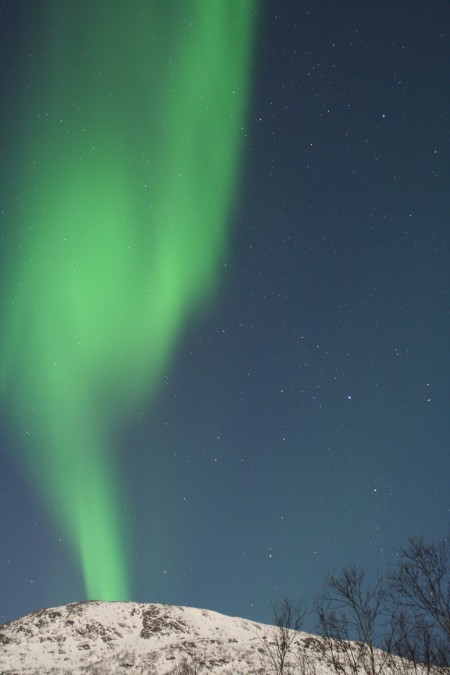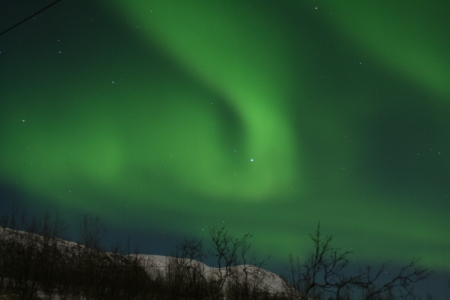A more personal post than usual today; if you dislike reading about other people’s holidays then you may wish to look away now!
We’ve been staying near Tromsø in the far North of Norway for the last week or so; it was my 30th birthday a couple of weeks ago, but at that point the days here were two hours long! So we thought we’d delay the trip slightly. Even though it is well inside the Arctic circle (which – I didn’t previously know this – delineates those Northern parts which have some period of 24-hour darkness in winter, and 24-hour light in summer), Tromsø is quite a thriving little city, and it boasts various “most Northerly” things, such as university, brewery, botanic gardens, and (perhaps slightly less commendably) Burger King. Not quite as cold as you might expect, by virtue of its coastal location, and the fact that it is situated right at the very Northern end of the Gulf Stream. However, that is not to say it is not cold! The mercury hasn’t risen above freezing since we’ve been here, and it has got as low as -19°C on a couple of nights.
In fact this is one of the coldest and driest winters they’ve had here: usually a huge amount of snow falls over winter, but this year there has been almost none. As a result the earth has been exposed to the full extent of the cold, meaning that the frost has permeated deep into the ground, and the spring which supplies the water to our cottage has partially frozen (finding and maintaining one’s own water supply is clearly rather more laborious here than in warmer climes). So we have had little more than droplets of water coming from the taps. Luckily there is a sauna in the house, so it is possible to mitigate the icy trickle which is our shower by heating oneself up as much is as bearable beforehand.
It’s a very beautiful place; quite mysterious, with magnificent mountains, a perpetually setting sun, frozen fjords and rivers, and (for some reason I have not yet worked out) occasionally steaming seas. Perhaps most magical of all, however, and one of the main draws for us, is that Tromsø lies right in the centre of the Northern auroral zone . This is the band between around 10 and 20 degrees of latitude from the magnetic North pole, to which charged particles from the sun are drawn by the Earth’s magnetic field. These particles react with atoms in the atmosphere, in much the same way as electricity reacts with the gas in a neon tube, to create a wonderful spectacle known as the aurora borealis, or Northern lights (the Southern equivalent is known as the aurora australis).
I had seen the Northern lights once before as a teenager in the South of Scotland (when the solar wind is especially strong, the phenomenon occurs at lower latitudes). I didn’t know what it was at the time, which I think added to the general sense of wonder – scientific explanations have a way of taming the awe of the inexplicable. However, they were very faint, and I wasn’t quite prepared for quite how beautiful a full display would be. It consists of mostly ghostly green lights, with occasional hints of red, blue and yellow (the colours depending on the atmospheric gases reacting). They resemble giant flames, or luminous clouds of gas; constantly shifting and moving; often in a number of bands across the sky, but sometimes snaking into coils and spirals. There is always a sense of rippling and flickering, and when they are at their peak they seem to burn fiercely, flitting quickly in and out of existence.
Unsurprisingly, there have been some quite outlandish sources attributed to them by different native peoples of polar regions. It seems to vary from region to region whether they were thought of as having positive or negative connotations; whether they were gifts from a benign god, or bad omens and symbols of celestial displeasure. They are known in Scotland (especially Orkney and Shetland, where they are relatively common) as the “Merry Dancers”, which seems quite appropriate. Slightly less understandable is the traditional French term, “chavres dansantes”, which translates as “dancing goats”. The Inuit attached spiritual significance to them, believing them to be images of their ancestors. What these ancestors were interpreted as doing seems to have varied from tribe to tribe, with some believing them to be simply sending messages through dance, and others perceiving them to be playing football with a walrus skull. Still more inverted this latter myth, and saw walruses playing football with a human skull!
Other odd interpretations come from different tribes of native North Americans. Most of these seem to be based on the assumption that the lights were from large fires in the North, but there any trace of common sense seems to end. For example: the Makah Indians of Washington State thought that there was a tribe of dwarfs living in the far North, who were “half the length of a canoe paddle and so strong they caught whales with their hands”. These dwarfs boiled whale blubber over the fires which caused the lights. On the other hand, the Menominee Indians of Wisconsin thought the fires were from torches used by friendly giants to spear fish at night.
I suppose these outlandish explanations go some way to conveying the mysteriousness of the lights…you could probably see whatever you wanted in them if you looked hard enough. There are also records of strange phenomena occurring when the lights appear, such as whistling and crackling sounds in the sky, and interference with electrical devices: there are even reports of battery-powered radios working without batteries during particularly strong events. Our radio would make such odd sounds when they were active that we had to switch it off.
Here in Tromsø the northern lights are just a part of life – in the winter months they appear roughly every other clear night to some extent, so seeing them during a trip here is really just a function of the weather. We’ve been very lucky in this respect, and have seen them 4 nights out of 7, sometimes quite faintly, but once or twice utterly spectacularly. So, if you want to see the Northern Lights, and live in Europe, I highly recommend coming to Tromsø. Just check the weather forecast, and, as soon as there is sure to be a clear spell, hop on a flight. Just be sure to bring some thermal underwear, and lots of money (a pint of beer costs about £9.50)!
You may also want to look at this very useful website, which collates all the possible data you might need to predict a display, such as geomagnetic activity (if you are looking at this post sometime soon after I have written it, notice the great activity around the 24th/25th January 2012 – the lights were visible as far South as London at that point), the current location of the auroral zone, and a 360° webcam of the skies above Tromsø.
Below are some photos.






 Posted by Adam Bohn
Posted by Adam Bohn 